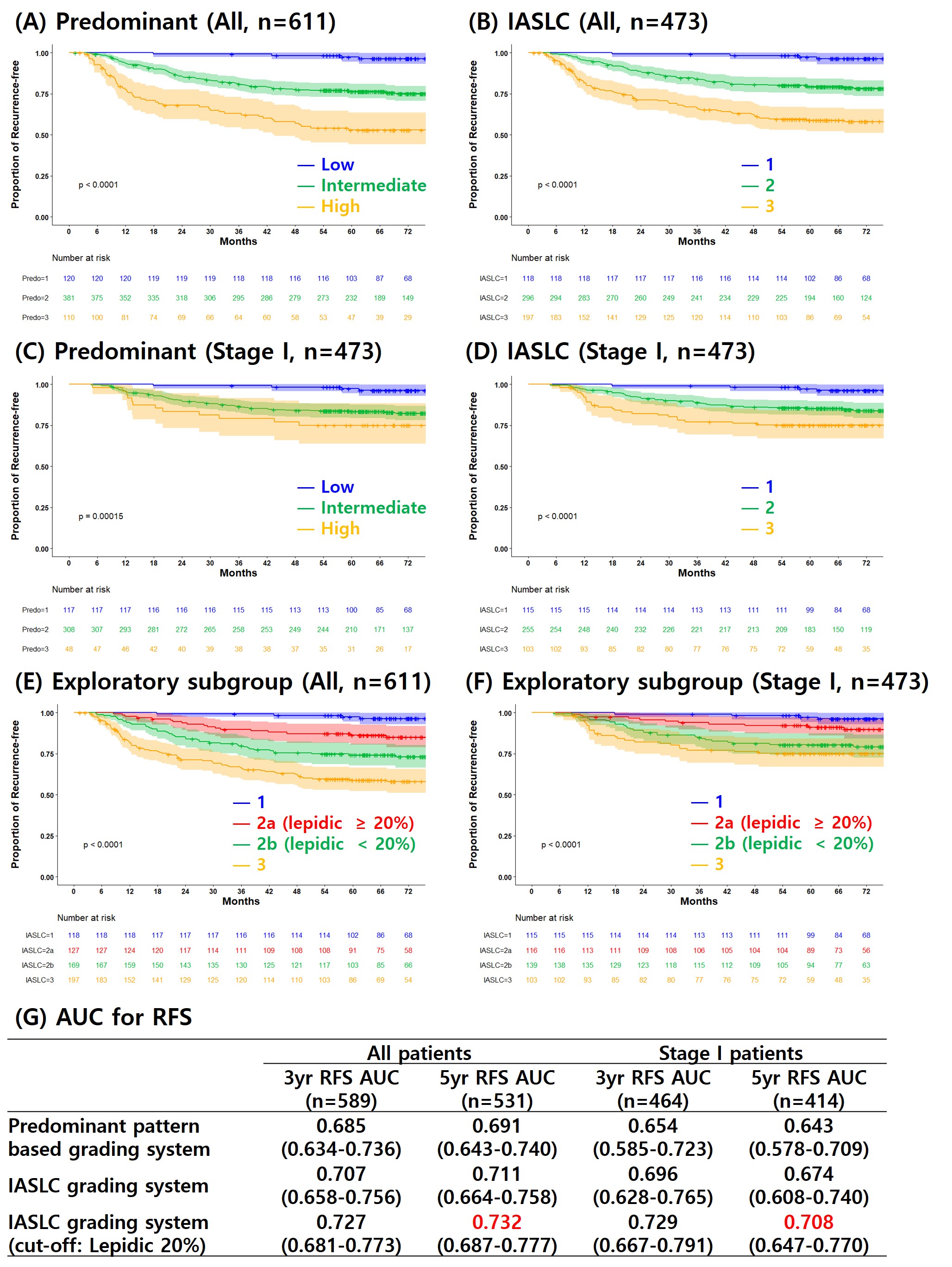초록접수 현황
| 20F-140 | 구연 발표 |
Newly Proposed Grading System for Invasive Pulmonary Adenocarcinoma by the International Association for the Study of Lung Cancer Pathology Committee: A Validation Study
Byung Jo Park1, Young Ho Yang1, Ha Eun Kim1, Go Eun Byun1, Seong Yong Park1, Jin Gu Lee1, Dae Joon Kim1, Hyo Chae Paik1, Kyoung Young Chung1, Chang Young Lee1
1 Department of Thoracic and Cardiovascular Surgery, Yonsei University College of Medicine, Seoul, Republic of Korea
Purpose : The International Association for the Study of Lung Cancer (IASLC) pathology committee recently proposed a new grading system for invasive pulmonary adenocarcinoma by the combination of predominant plus high-grade histologic pattern with a cutoff of 20% for the latter. This study aimed to evaluate the discriminatory ability and prognostic performance of the proposed grading system for invasive pulmonary adenocarcinoma in a large independent NSCLC cohort.
Methods : We analyzed 611 pulmonary invasive adenocarcinoma patients with reports of the semi-quantitative estimation of all patterns of 5% increment between 2012 and 2015.
Results : Analysis of recurrence-free survival (RFS) revealed that the newly proposed IASLC grading system (AUC= 0.711) for invasive pulmonary adenocarcinoma has better discriminatory ability than the previous predominant pattern-based grading system (AUC= 0.691). In the stage I patients, the stratification of survival between the 3 grades was more evident with the IASLC grading system than the predominant pattern-based grading system (p < 0.0001 versus p= 0.00015, AUC= 0.674 versus AUC= 0.643). Furthermore, the IASLC grading system group 2 patients still have prognostic heterogeneity. The discriminatory ability can be improved by applying a 20% cutoff to the lepidic pattern of group 2 patients (AUC= 0.732).
Conclusion : The newly proposed grading system for invasive pulmonary adenocarcinoma by the IASLC pathology committee has better discriminatory ability than the previous predominant pattern-based grading system. It would be better to classify the groups by dividing group 2 into two groups based on the proportions of lepidic pattern. A large-scale prospective study is needed to validate these grading systems.
Methods : We analyzed 611 pulmonary invasive adenocarcinoma patients with reports of the semi-quantitative estimation of all patterns of 5% increment between 2012 and 2015.
Results : Analysis of recurrence-free survival (RFS) revealed that the newly proposed IASLC grading system (AUC= 0.711) for invasive pulmonary adenocarcinoma has better discriminatory ability than the previous predominant pattern-based grading system (AUC= 0.691). In the stage I patients, the stratification of survival between the 3 grades was more evident with the IASLC grading system than the predominant pattern-based grading system (p < 0.0001 versus p= 0.00015, AUC= 0.674 versus AUC= 0.643). Furthermore, the IASLC grading system group 2 patients still have prognostic heterogeneity. The discriminatory ability can be improved by applying a 20% cutoff to the lepidic pattern of group 2 patients (AUC= 0.732).
Conclusion : The newly proposed grading system for invasive pulmonary adenocarcinoma by the IASLC pathology committee has better discriminatory ability than the previous predominant pattern-based grading system. It would be better to classify the groups by dividing group 2 into two groups based on the proportions of lepidic pattern. A large-scale prospective study is needed to validate these grading systems.

책임저자: Chang Young Lee
Department of Thoracic and Cardiovascular Surgery, Yonsei University College of Medicine, Seoul, Republic of Korea
발표자: Chang Young Lee, E-mail : cyleecs@yuhs.ac


